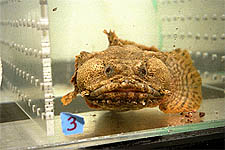 Box office science fiction hit, Guardians of the Galaxy, offers an engaging after-the-credits teaser between the character Taneleer Tivan—The Collector who appears in other Marvel Comics—and two of his remaining, living space explorers: a canine cosmonaut and Howard The Duck.
Box office science fiction hit, Guardians of the Galaxy, offers an engaging after-the-credits teaser between the character Taneleer Tivan—The Collector who appears in other Marvel Comics—and two of his remaining, living space explorers: a canine cosmonaut and Howard The Duck.
The duck is fictional.
The canine cosmonaut not so much.

It’s common knowledge to most of us that animals have been sent into space.
In 1947, fruit flies became the first animals launched. They were on board an American V-2 rocket which climbed to 68 miles (109 km) and then returned the flies to Earth alive.
In 1949, the first monkey was sent up, but wasn’t as lucky as the fruit flies. He died on impact due to parachute failure.

Photo credit: NASA
Why Send Animals?
NASA says sending animals into outer space can answer such questions as:
-
- Can a fish swim in microgravity? (ProbeNote: Microgravity is very weak gravity, as in an orbiting spacecraft.)
- Do bees make honey in space?
- Can ant farms exist on space stations?
Top Ten

During my recent research on extremophiles, I discovered another hitchhiker in the galaxy. In 2007, the water bear (aka Tardigrade, aka moss piglet) entered the ranks of launched critters.
And why not? He is the toughest dude on the planet. He can be:
-
-
- boiled
- frozen
- irradiated
- starved
- pressurized
- vacuum-packed
- and all with the remarkable tenacity to survive
-
Tardigrades received the undisputed honor of the number one spot on Wired’s Top Ten Things Launched Into Space in 2008 list. And is the first known animal to survive exposure to outer space.
Dr. Who?
TARDIS, for Tardigrades in Space, was the first research conducted to evaluate the water bears’ survival abilities in open space. On September 14, 2007, on board an unmanned Russian Foton-M3, thousands of bears along with 40 other European Space Agency (ESA) experiments were successfully launched and spent 12 days in orbit.
The experiments were exposed to microgravity and, in the case of the Tardigrades, to the harshness of open space. Two sets of Tardigrades were studied: one set was exposed to both space vacuum and solar radiation, and another set was exposed to space vacuum only.
Four species of Tardigrades were sent into space: Richtersius coronifer, Milnesium tardigradum, Echiniscus testudo, and Ramazzottius oberhaeuseri.
Survivors?
Many of the water bears survived the trip and even managed to continue reproductive processes. Fewer survived exposure to UV radiation. BUT some did.
Milnesium tardigradum proved the winner. About 12% of them recovered after exposure to UV-A and UV-B doses. A significant difference reported was that their egg production was lower than in the control animals that stayed on Earth. It was also reported that a few specimens exposed to the full UV range woke up and tried to reanimate, but failed and died a few days later.
Although nicknamed water bear, Tardigrades are anything but bear size. In fact, most are less than a millimeter in size. Their gait is said to resemble a slow moving, plump little bear ambling along on eight legs. This YouTube video gives us a peek at water bears.
Bear Facts
-
-
- Originally, German zoologist Johann August Ephraim Goeze gave the Tardigrade the name: kleiner Wasserbär—which means “little water bear” in German.
- In 1776, biologist Lazzaro Spallanzani gave the animal the name Tardigrada meaning “slow walker.”
- Water bears spend most of their lives on lichen and moss and can be found everywhere throughout the world.
- In order for the Tardigrade to accomplish such miraculous feats, he goes into an extreme resting stage: cryptobiosis. In this state, he is able to almost halt his metabolic process by replacing the water in his body with a sugar called trehalose. He loses 97%-99% of his total moisture and becomes a dried up little husk called a “tun.”
- In his tun state, this remarkable little creature goes into suspended animation. Here, the Tardigrade’s body dries out and appears as a lifeless ball. Their metabolism may decline to as little as 0.01 percent of its normal rate. They are able to survive for years, perhaps even decades, waiting for moisture in order to reanimate.
- When reintroduced to water, he reanimates.
- The water bear’s origins and its evolutionary journey remain a mystery to scientists, with enthusiasts like Mike Shaw raising the question: If they survived outer space, is that where they came from?“If you believe that tardigrades came from space, as some think, then you could say that all life came from space,” says Shaw on his website.
- One thing most Tardigrade researchers agree upon, however, is that they are an ancient group of animals with their oldest known fossils coming from mid Cambrian, ca.—half a billion years ago. The delicate nature of their tun makes it difficult for fossils to form or be retrieved.
- There is actually a water bear stuffed toy you can purchase for your kids, grandkids, or self.
- The Tardigrades even have their very own newsletter.
-
Fame But No Fortune
Add to the above list of accomplishments, Tardigrades are movie stars. Season one, episode 14 of Star Trek: Discovery, introduced a new crew member, Ripper, who is none other than the Tardigrade. Fictional Ripper is much larger than an actual tiny Water Bear, however, he too is capable of entering a state of cryptobiosis.
Because of its unique biological capabilities, the crew uses Ripper to navigate the mycelial network and pilot the ship. But when he becomes exhausted, it retreats to a state of cryptobiosis which forces Lt. Paul Stamets to inject himself with Tardigrade DNA.
GameStop Universe offers a YouTube, recapping episode 14 which features Ripper—titled “The Butcher’s Knife Cares Not For The Lamb’s Cry.” So if you’re not a Star Trek fan, but are curious, you can view this short video and watch as real life collides with SyFy.
ProbeFiling
So what? Sure they’re cute but…
Why all the fascination surrounding water bears?
-
-
- By studying the Tardigrades’ gene functions, Tardigradologists (yes, it’s a real thing) hope to gain insight into the evolution of developmental mechanisms and survival in extreme environments. Researchers at the University of North Carolina are developing a tardigrade species to find answers to just such questions encompassing evolutionary diversity and survival.
- By sending the water bears into outer space and then studying the results, some of us may form the conclusion that it is possible that beginning life traveled through space and survived.
- Currently, real-life scientists are actually injecting Tardigrade DNA into human cells. The study of the Tardigrades’ unique ability to repair damaged DNA opens up huge possibilities for the future of mankind in his battle against disease and environmental stressors. Ingemar Jönsson—specialist in Tardigrade biology, pioneer in the study of this amazing creature, and Associate Professor at Kristianstad University in Sweden—considers their most impressive ability to be:
-
“Their ability to dehydrate completely when the surrounding conditions dry out, and stay in that state without any metabolism for many years or even decades, is clearly remarkable.”
Still a Mystery
The Tardigrades’ ability to dry-out and reanimate remains a mystery.
“We know that the animal must somehow protect its basic cell structures from collapsing when water is withdrawn, and repair the damage that arises, but how this is done is unclear,” says Professor Jönsson.
YouTube by Tardigrade enthusiast and writer, Mike Shaw.
It seems there is much we can learn from our tiny Tardigrades.
QUESTION: Could they hold answers to the beginning of life on Earth?
I know I will never again be able to sit upon a mossy rock after a hike without worrying if I’m smashing thousands of water bears.
- Urban Legend in the Making - April 22, 2024
- Coghlan’s Traveling Coffin Urban Legend - April 4, 2024
- Richmond Vampire Urban Legend - March 7, 2024

3 replies on “Do Water Bears Offer Answers for Earthlings?”
I guess these critters are fun to study, and may be useful for something or other, but to me they are so creepy! I’d say they are fuel for nightmares and horror movies! haha 🙂
Hey Barbara, you are too funny. Yep, water bears are not everyone’s cup of tea, for sure. But they do toy with one’s imagination. Thank you for commenting. —Clara
haha – yes, that’s true! Hope your weekend is going good! 🙂